Schemes and methods of connecting solar panels: how to properly install a solar panel
An alternative energy source based on solar panels is an excellent option for organizing an independent power supply.It will provide high energy efficiency not only on hot days, but also in cloudy weather. It would be nice to have such a device at home, wouldn't it?
To do this, you just need to correctly select the technical components and carry out installation. Anyone can do this if they know the diagrams and methods of connecting solar panels. We will tell you how to build a productive system that converts “green energy” into electricity needed to power household equipment.
In addition, you will learn how to choose a place to install solar panels and how to combine them with a stationary electrical network. Useful tips and important recommendations will provide effective assistance to home craftsmen. To make it easier to understand, thematic photographs, diagrams and videos are provided.
The content of the article:
Solar battery device
When planning to connect solar panels yourself, you need to have an idea of what elements the system consists of.
Solar panels consist of a kit photovoltaic batteries, the main purpose of which is to convert solar energy into electrical energy. The current strength of the system depends on the intensity of the light: the brighter the radiation, the greater the current generated.
The main structural elements of the system are:
- Solar battery – converts sunlight into electrical energy.
- Battery – a chemical current source that accumulates generated electricity.
- Charge controller – monitors battery voltage.
- Inverter, which converts the direct electrical voltage of the battery into alternating 220V, which is necessary for the functioning of the lighting system and the operation of household appliances.
- Circuit breakers, installed between all elements of the system and protecting the system from short circuits.
- Set of MC4 standard connectors.
In addition to the main purpose of the controller - to monitor the battery voltage, the device turns off certain elements as necessary. If the indicator at the battery terminals during the daytime reaches 14 Volts, which indicates they are being overcharged, the controller interrupts charging.
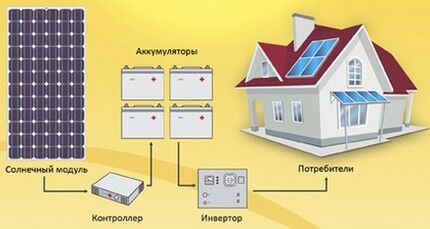
At night, when the battery voltage reaches an extremely low level of 11 Volts, the controller stops the operation of the power plant.
Where is the best place to install the panels?
The first thing you need to do before installing and connecting a solar battery is to decide on the location of the unit.
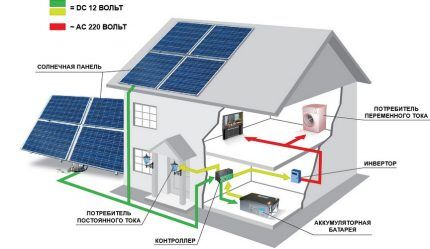
Solar panels can be placed in almost any well-lit point:
- on the roof of a country cottage;
- on the balcony of an apartment building;
- in the area adjacent to the house.
The main thing is to provide the necessary conditions for obtaining maximum electricity generation. One of these is the orientation and angle of inclination relative to the horizon.So the light-absorbing surface of the unit should be directed to the south.
Ideally, the sun's rays should fall on it at 90°. To achieve this effect, it is necessary to select the optimal slope angle depending on the climatic conditions of the region. This indicator is different for each region.
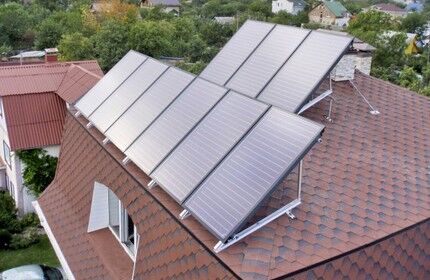
For example, in the Moscow region, the angle of inclination of the surface of solar panels for the summer months is 15-20°, and in the winter months it changes to 60-70°.
When placing solar panels in the area adjacent to the house, it is better to raise the panels above the soil surface by at least half a meter - in case a large amount of snow falls. This solution is also correct in the sense that it provides sufficient distance for air circulation.
It is worth remembering that even a small shadow has a detrimental effect on the electricity generation of the unit. Panels should be placed only in places that are not subject to even the slightest shading.
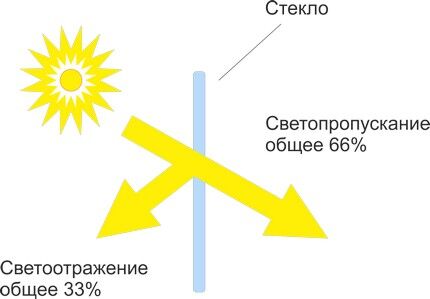
There are several ways to fix the panels:
- by activating the clamping clamps;
- by bolting through through holes located at the bottom of the frame.
The supporting structure must be made of corrosion-resistant materials. Regardless of the installation method, you cannot make changes to the panel design yourself or drill additional holes.
It is the homeowner's job to keep the panels clean. Collecting dust, snow and bird droppings on the screen will reduce the amount of electricity produced by the system by at least 10%.
Solar battery connection options
Solar panels are made up of several individual panels. To increase the system output parameters in the form of power, voltage and current, elements are connected to each other using the laws of physics.
Connecting several panels to each other can be done using one of three solar panel installation schemes:
- parallel;
- sequential;
- mixed.
A parallel circuit involves connecting terminals of the same name to each other, in which the elements have two common nodes for the convergence of conductors and their branching.
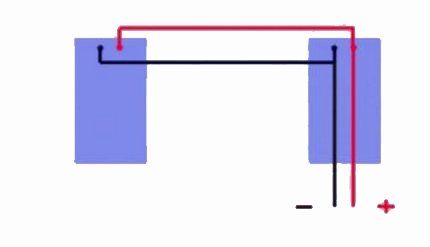
The maximum possible output current in a parallel circuit is directly proportional to number of connected elements. The principles for calculating quantities are given in our recommended article.
A series circuit involves connecting opposite poles: the “plus” of the first panel to the “minus” of the second. The remaining unused “plus” of the second panel and the “minus” of the first battery are connected to the controller located further along the circuit.
This type of connection creates conditions for the flow of electric current, in which the only path remains for the transfer of energy from the source to the consumer.
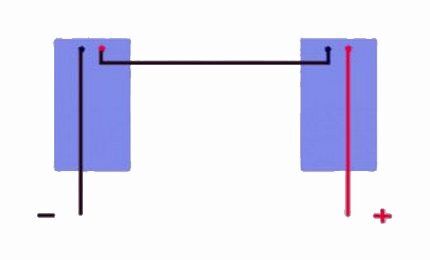
A series-parallel or mixed circuit is most often used when it is necessary to connect several groups of batteries. By using this circuit, both the voltage and current can be increased at the output.

This option is also beneficial in the sense that if one of the structural elements of the system fails, the other connecting circuits continue to function. This significantly increases the reliability of the entire system.
The principle of assembling a combined circuit is based on the fact that devices within each group are connected in parallel. And all groups are connected in one circuit in series.
By combining different types of connections, it is not difficult to assemble a battery with the required parameters. The main thing is that the number of connected elements must be such that the operating voltage supplied to the batteries, taking into account its drop in the charging circuit, exceeds the voltage of the batteries themselves. batteries, and the battery load current provided the required amount of charging current.
Solar power system assembly diagram
Connection of solar panels is carried out using built-in connecting wires with a cross-section of 4 mm2. Single-core copper wires, the insulating braid of which is resistant to ultraviolet radiation, are best suited for this purpose.
If you use a wire whose insulation is not resistant to UV rays, it is recommended to lay it externally in a corrugated sleeve.
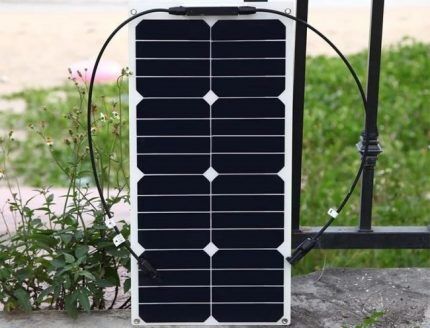
Regardless of the chosen scheme, before connecting solar panels It is imperative to check the correctness of the electrical installation.
When connecting panels, it is not recommended to exceed the technical requirements for the permissible current and maximum voltage of other devices. It is important to adhere to the charge controller and inverter specifications specified by the manufacturer.
The standard assembly diagram for the simplest solar power plant is as follows.
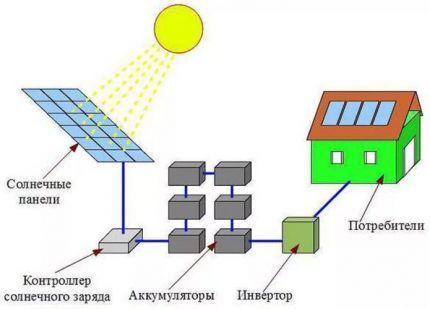
To avoid breakage controller, when connecting system elements, it is important to follow the sequence.
Installation work is carried out in several stages:
- The battery is connected to the controller using the appropriate connectors and remembering to observe the polarity.
- A solar battery is connected to the controller through connectors, maintaining the same polarity.
- A 12 V load is connected to the controller connectors.
- If it is necessary to convert the electrical voltage from 12 to 220 V, then an inverter is included in the circuit.It is connected only to the battery and in no case directly to the controller.
- Electrical appliances designed for a voltage of 220 V are connected to the free output of the inverter.
After making the connection, you need to check the polarity and measure the open circuit voltage of the panels. If the indicator differs from the passport value, the connection is not made correctly.

At the final stage, the solar battery must be grounded. To minimize the likelihood of a short circuit, fuses are installed at the connection points between the battery, inverter and controller.
The energy of solar power plants will be used in powering low-power household appliances and in charging batteries of mobile equipment:
Those wishing to build a solar battery with their own hands will be helped by the information provided. in the next article.
Connecting multi-directional elements
When using a sequential solar panel installation scheme, in order not to reduce the efficiency of the devices, all panels of the common circuit should be placed at the same angle and on the same plane.
If the panels are located in different planes, this may lead to the fact that the closest or more illuminated one will work more powerfully than those located a little further away.
This means that the near panel will generate electricity, some of which will be released to heat the distant panels. And the reason lies in the fact that current flows along the path of least resistance. To minimize losses, it is better to use a separate controller for each panel.

The issue can also be resolved by installing cut-off diodes. They are placed inside between the plates. Thanks to this, while delivering maximum power, the plates do not overheat.
The voltage drop in the connections, as well as the wires themselves, of the low-voltage part of the system is also important.
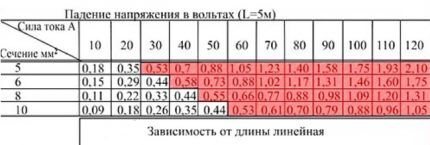
An example is the fact that for a meter piece of cable with a cross section of 4 mm2 when a current of 80A (voltage 12 V) passes, the values drop by 3.19%, which is 30.6 W. When twisting is activated, the voltage drop can vary from 0.1 to 0.3 V.
Combination of solar energy and stationary network
When planning to use electricity from the sun in parallel with an equipped centralized stationary network, the connection diagram is made slightly different. And the main reason for this decision is that the private consumer does not have the opportunity to “dump” the remaining energy.
And this can provoke voltage surges lasting up to one second.
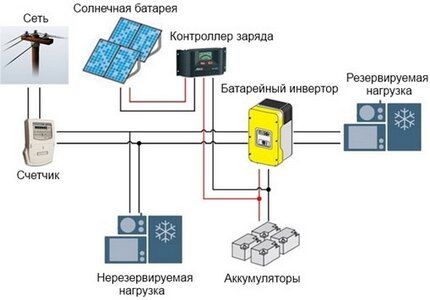
According to the above diagram, the voltage from the heliofield is first directed towards the battery, and from there it is transmitted to the load.
When designing this installation option, it is worth taking two types of load into account:
- non-reservable – lights in the house, household appliances, etc.;
- reserved – emergency lighting, refrigerator, electric boiler.
Keep in mind: the larger the battery capacity, the longer the backup electrical appliances will work in autonomous mode.
When choosing this method of generating energy into the network, be prepared for the fact that you will have to apply for permission from local power grids.
Although inverters for solar panels produce voltage, the quality of which is sometimes higher than that in the centralized network; local power networks do not give the go-ahead for the electric meter to rotate in the opposite direction.
For this reason, according to the scheme, solar inverters stop working when the voltage in the network is lost. And the redundant load begins to be “powered” from the battery.
Conclusions and useful video on the topic
The authors of the video material, which is provided below, share their personal experience and analyze the nuances of installing solar panels.
Video #1. An example of assembly and installation of a factory-standard system:
Video #2. How to install panels correctly:
There is nothing complicated in the process of connecting several panels with other elements of the system. But for a novice master, the process can become difficult. Therefore, if you do not have experience in calculations and installation skills, you should contact a specialist who has the necessary knowledge.
Would you like to tell us how you assembled your own solar power plant for your dacha or country house? Perhaps you know the subtleties of the process that are not described in the article? Please write comments in the block below, ask questions, share your opinion and photos on the topic of the article.




I'm about to convert my house from electric to solar panels. I have already installed solar-powered lights throughout the entire area. Of course, I will trust the installation of solar panels only to a professional, since objectively, without experience, I will not be able to do everything accurately. Tell me, if I plan to convert only part of my electrical appliances to solar energy, and leave some on electricity, is this possible?
Oleg, your question is answered in the section “Combining solar energy and a stationary network.” It is this combination that allows you to make maximum use of the energy of solar panels and use electrical appliances at any time, regardless of weather conditions.
Just don’t forget about such disadvantages as:
— If a shadow falls on one monoblock, it blocks the work of the others connected to it;
— Battery life up to 10 years;
— On sunny days, not only the maximum energy output occurs, but also the heating of the panels themselves (especially when there is no wind).And every degree increase in panel temperature reduces efficiency by an average of 0.5%;
— Dust on the surface reduces the efficiency of the panel;
— Over time, the efficiency of the panel decreases to 0.8% per year (actively in the first 2 years - up to 2%).
Having today panels with an efficiency of up to 20% (maximum for new ones), the prospect of their use is in most cases debatable; even in the absence of power grids, a simple diesel generator will become a more useful purchase.
Tell me how to connect solar panels and a 12-24 V, 20 A MMR controller. The voltage on the panels is 32-40 V, 280 W. How should I connect two panels - in series or in parallel?
In your case, it is better to use a series-parallel connection circuit, this is discussed in the article, read more carefully. It is this connection scheme that allows you to obtain the output voltage at which normal functioning of household appliances is possible.
As an example, I can give a connection diagram with an 80 A controller, but for your case it will also be relevant.
When installing all elements, be careful, in particular follow all instructions. For example, the inverter is connected only to the battery, and not directly to the controller, to avoid damage to the inverter. After you assemble the circuit, check the polarity and measure the open-circuit voltage, which should coincide with the nameplate voltage. If it is different, then the circuit is assembled incorrectly.
So a series connection gives the summation of the voltage. And parallel is the summation of amperage.
Wow: the cost of the panel is from 200 thousand rubles.What if it breaks? Yes, 200 thousand will be enough for me to pay for regular electricity until the end of my days.
Yes, the price is rather high, but you don’t have to worry about the solar panel breaking. I won’t explain for a long time how and why solar panels are now not afraid of mechanical influences (impact, falling, bending). I will only say that special technologies and chemical processes are used in their production.
If you don’t believe me, then you should have a crash test “in Russian”, as they say https://www.youtube.com/watch?v=iBbdW7pxBTg It can be seen that there is no video editing - anyone can test the solar panel for strength.
Regarding the price, the more sunny days a year in the latitudes where the installation of solar panels is planned, the shorter their payback period. It is clear that purchasing such panels for residents of the northern regions is definitely not economically feasible.
I don’t understand, what other “permission” needs to be issued? I assembled my receiver, assembled the panel, powered it from it. What does the city power grid even care about my personal belongings, hobbies, and household devices? We pay them for energy from the network. We don’t use it - there’s nothing to pay for, nothing to negotiate about. It seems like they are connected on a voluntary basis, or am I not aware of something?
Hello! I want to build a solar power plant with a power of 1 mW! How to connect this station to a centralized network?! What kind of inverter do I need, how many mW?! How will the panels be connected in parallel or in series?! Thank you in advance!